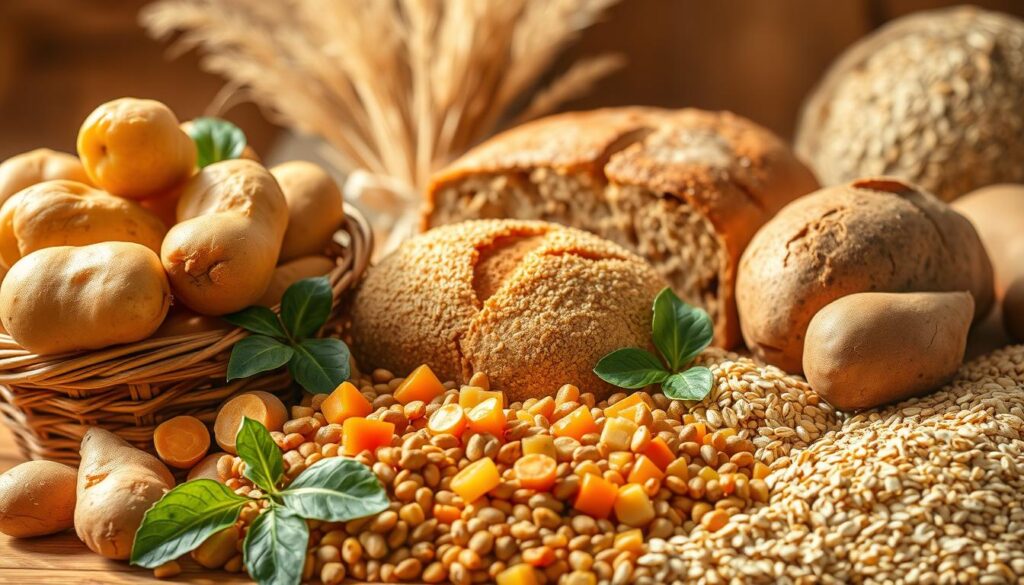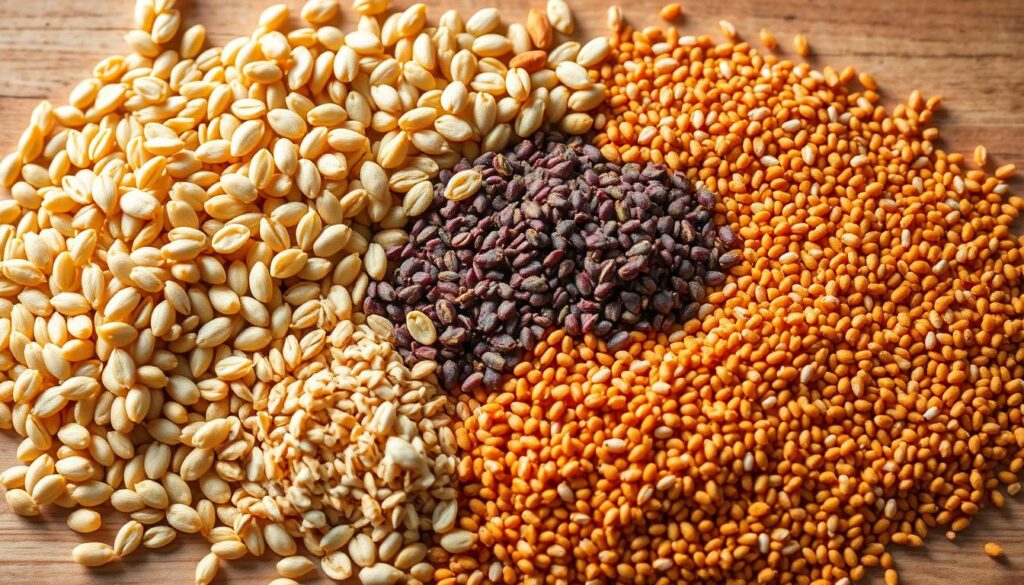Are you tired of feeling sluggish and uncertain about how to fuel your body for optimal energy and wellbeing? The key to unlocking sustained vitality lies in understanding the importance of fiber-rich starchy carbohydrates in your diet.
A well-balanced diet rich in starchy foods can provide the necessary energy and nutrients for overall health. However, not all starchy foods are created equal. The distinction between refined and unrefined starches can significantly impact your health.
By incorporating the right types of starchy carbohydrates into your meals, you can debunk the myth that these foods are inherently “fattening” and instead, support your weight management goals.
Key Takeaways
- Understand the difference between refined and unrefined starches and their impact on health.
- Learn how to choose fiber-rich starchy foods for sustained energy.
- Discover practical ways to incorporate these foods into your daily meals.
- Debunk common myths about starchy foods being “fattening.”
- Support your weight management goals with the right dietary choices.
Understanding Starchy Carbohydrates and Their Role in Nutrition
Understanding starchy carbohydrates is essential for making informed dietary choices that impact our energy levels and overall well-being. Starchy carbohydrates are a crucial macronutrient found in various foods, including potatoes, bread, rice, pasta, and cereals, making up about one-third of a balanced diet.
What Are Starchy Carbohydrates?
Starch is a type of carbohydrate consisting of glucose molecules. Glucose provides cells with energy

foods come in many forms and are often consumed as staple foods in diets worldwide. Legumes, grains, and root vegetables are examples of starchy foods. While starchy foods are naturally high in starch, they also contain fiber, vitamins, minerals, and naturally occurring sugars.
As highlighted by a study, “Diets rich in whole grains and fiber can lead to improved health outcomes and reduced risk of chronic diseases.”
A diet rich in whole grains can lower the risk of heart disease, type 2 diabetes, and certain cancers.
The Difference Between Refined and Unrefined Starches
The distinction between refined and unrefined starches is significant. Refined starches, such as white bread and white rice, have been processed to remove beneficial components like fiber, vitamins, and minerals. In contrast, unrefined starches, such as brown rice and whole wheat bread, retain these nutrients, making them a healthier choice.
| Characteristics | Refined Starches | Unrefined Starches |
|---|---|---|
| Fiber Content | Low | High |
| Nutrient Retention | Low | High |
| Examples | White bread, white rice | Brown rice, whole wheat bread |
Understanding the difference between refined and unrefined starches can help individuals make healthier dietary choices, ultimately supporting their overall health and energy needs.
The Health Benefits of Fiber-Rich Starchy Foods
Starchy foods rich in fiber play a crucial role in maintaining overall health and well-being. These foods are a vital component of a nutritious diet, providing essential nutrients and energy for the body.

Energy and Brain Function
Fiber-rich starchy foods provide a steady release of energy to fuel the body and brain throughout the day. The brain relies heavily on glucose from carbohydrates to function optimally, and these foods provide this essential fuel in a slow, consistent manner.
Digestive Health and Satiety
The fiber in these foods promotes digestive health by moving waste efficiently through the system, preventing constipation, and supporting a healthy gut microbiome. This can help reduce the risk of developing heart disease. Moreover, fiber-rich starchy foods create a feeling of fullness (satiety), which helps prevent overeating and supports weight management goals.
Blood Sugar Management
These foods play a crucial role in blood sugar management by slowing the absorption of glucose into the bloodstream, which helps prevent dangerous spikes and crashes in blood sugar levels. This is particularly beneficial for maintaining stable energy levels and overall health.
Maintain Your Meals Based on Fiber-Rich Starchy Carbohydrates
To ensure you’re getting the most nutritional benefits, it’s crucial to understand how to maintain your meals based on fiber-rich starchy carbohydrates. This involves being mindful of the types and amounts of starchy foods you consume daily.
Recommended Daily Intake
The FDA suggests a daily intake of 275g of total carbohydrates for the average person. However, this amount can vary based on individual factors such as height, weight, and activity level. Starchy foods, being a significant source of fiber and micronutrients, should make up about one-third of your daily food intake. Focusing on whole grain and unrefined options is recommended.
For a balanced diet, it’s essential to understand the recommended daily intake of starchy foods. According to the Eatwell Guide, starchy foods should constitute about 36.7% of your daily food intake. Choosing higher fiber wholegrain varieties like wholewheat pasta and brown rice, and leaving skins on potatoes, can significantly enhance your fiber intake.
Balancing Your Plate with Starchy Foods
To balance your meals effectively, use the plate method: allocate one-quarter of your plate to fiber-rich starchy foods, one-quarter to protein, and half to vegetables and fruits. Being mindful of portion sizes is also crucial, as a serving of starchy carbohydrates is typically about 1/2 cup of cooked pasta, rice, or potatoes, or one slice of whole grain bread.
Distributing your starchy carbohydrate intake across meals throughout the day helps maintain steady energy levels and better blood sugar control. It’s also important to remember that while starchy foods are nutritious, added fats like butter, oil, or creamy sauces can significantly increase calorie content.
- Focus on whole grain and unrefined starchy foods.
- Use the plate method for meal planning.
- Be mindful of portion sizes.
Top Fiber-Rich Starchy Foods to Include in Your Diet
Fiber-rich starchy foods play a significant role in a healthy diet, providing essential nutrients and satiety. Incorporating these foods into your meals can have a substantial impact on your overall health and nutrition.
Whole Grains
Whole grains are a fundamental component of a fiber-rich diet. They include options like brown rice, whole wheat pasta, barley, quinoa, oats, and bulgur wheat. These foods retain their natural fiber and nutrient content, making them a healthier choice compared to refined grains. Experimenting with ancient grains like farro, spelt, and amaranth can also add variety and nutritional value to your meals.

Legumes
Legumes are an excellent source of protein, fiber, and complex carbohydrates. They are also relatively inexpensive and accessible. Incorporating beans, lentils, chickpeas, and split peas into your diet can provide a nutritional boost. Legumes are particularly noteworthy as they offer 2-3 times more protein than rice and wheat, making them a valuable component of a balanced diet.
Starchy Vegetables
Starchy vegetables like potatoes (especially with skins on), sweet potatoes, corn, peas, and winter squash are rich in nutrients and fiber. These vegetables can be prepared in numerous healthy ways, making them a versatile addition to meals. They provide valuable nutrients along with their starch content, contributing to a balanced and satisfying diet.
The Glycemic Index: Choosing the Right Starchy Foods
To maintain stable energy levels and manage blood sugar, understanding the Glycemic Index of various foods is essential. The Glycemic Index (GI) is a measure that ranks foods based on how quickly they raise blood sugar levels.
The GI is measured by giving people test foods and then measuring the levels of glucose in the blood compared to an equivalent amount of pure glucose. Glucose is given a score of 100, and then foods are ranked accordingly.
Understanding Low, Medium, and High GI Foods
Foods are categorized into three GI groups: low, medium, and high. A GI of 70 or more is considered ‘high’, 56-69 is ‘moderate’, and 55 or less is ‘low’. High GI foods cause rapid spikes in blood sugar, while low GI foods result in slower, more gradual increases.
- Low GI foods (55 or less) provide sustained energy and are beneficial for managing blood sugar levels.
- Moderate GI foods (56-69) cause moderate increases in blood sugar.
- High GI foods (70+) lead to rapid spikes in blood sugar levels.

How GI Affects Blood Sugar and Energy Levels
The GI directly impacts blood sugar levels and energy. Consuming low GI starchy foods like sweet potatoes, legumes, and whole grains provides steady energy throughout the day. In contrast, high GI foods can lead to energy crashes after consumption.
For individuals with type 2 diabetes or prediabetes, choosing lower GI starchy foods is particularly important for managing blood sugar levels. The Glycemic Load (GL) concept further refines this by considering both the GI and the amount of carbohydrate in a food, providing a more accurate picture of its impact on blood sugar.
By understanding and applying the GI concept, individuals can make informed dietary choices that help maintain stable energy levels and manage blood sugar effectively.
Meal Planning Strategies for Fiber-Rich Starchy Carbs
In accordance with the Eatwell Guide, starchy foods should make up over a third of our diet, emphasizing the importance of choosing higher fiber wholegrain varieties like wholewheat pasta and brown rice, and leaving skins on potatoes. To incorporate more fiber-rich starchy carbohydrates into our meals, we need to plan our meals effectively. Here are some strategies to help you do so.
Breakfast Ideas
Starting your day with fiber-rich breakfast options can set the tone for a healthy diet. Some ideas include:
- Steel-cut oatmeal topped with fruits and nuts
- Whole grain toast with avocado
- A breakfast burrito with beans and vegetables wrapped in a whole wheat tortilla
These fiber-rich foods provide energy and keep you full until lunchtime.
Lunch and Dinner Options
For lunch and dinner, build your meals around fiber-rich starchy foods. Some examples are:
- Grain bowls with quinoa or brown rice
- Whole wheat pasta salads with vegetables
- Bean and vegetable soups served with whole grain bread
- Stir-fries with brown rice and plenty of colorful vegetables
These meals are not only rich in fiber but also provide a good mix of other essential nutrients.
Healthy Snacks
Keeping healthy snacks on hand is crucial for maintaining energy levels between meals. Some healthy snack options that incorporate fiber-rich starchy foods are:
- Whole grain crackers with hummus
- Air-popped popcorn
- Roasted chickpeas
These snacks are not only rich in fiber but also in other nutrients, making them a great addition to your diet.
As emphasized by dietary guidelines, increasing the consumption of starchy foods, particularly higher fiber foods like wholemeal breads and high-fiber breakfast cereals, is crucial. We should aim to increase our starchy food consumption from 281g to 473g per day.
According to a study, “the consumption of starchy foods as a food group would have to significantly increase…” to meet the recommended nutrient intake. This underlines the importance of meal planning to ensure we are consuming enough fiber-rich starchy foods.
“A well-planned meal can help you include a variety of fiber-rich starchy foods in your diet, thus maintaining a balanced diet,” says a nutrition expert.
To make meal preparation easier, batch cooking fiber-rich starchy foods like brown rice, quinoa, or roasted sweet potatoes at the beginning of the week can be very helpful. When eating out, look for menu items that include whole grains, beans, or starchy vegetables, and do not hesitate to ask for substitutions like brown rice instead of white.
Here is a simple table showing some fiber-rich starchy foods and their fiber content:
| Food | Fiber Content (g) |
|---|---|
| Brown rice (1 cup cooked) | 3.5 |
| Whole wheat pasta (1 cup cooked) | 4.5 |
| Quinoa (1 cup cooked) | 5.2 |
| Roasted sweet potatoes (1 medium) | 4.0 |
Special Dietary Considerations
For individuals with specific dietary needs or health conditions, incorporating fiber-rich starchy carbohydrates requires careful consideration. While these foods are generally beneficial, certain health conditions may necessitate a more tailored approach to their inclusion in the diet.
Fiber-Rich Starchy Carbs for People with Diabetes
People with diabetes can still enjoy fiber-rich starchy carbohydrates, but they must do so with caution. The American Diabetes Association suggests that individuals with type 1 diabetes can benefit from carb counting, allowing them to adjust their insulin dosages accordingly. For those with type 2 diabetes, spreading carbohydrate intake evenly throughout the day and avoiding highly processed foods is advisable.
- Choose lower glycemic index options to maintain stable blood sugar levels.
- Practice portion control to manage carbohydrate intake effectively.
- Distribute carbohydrate consumption throughout the day.
A study shows that people with type 2 diabetes can improve blood sugar control and reduce insulin resistance by carefully selecting and consuming fiber-rich starchy foods.
| Diabetes Type | Dietary Recommendation | Benefit |
|---|---|---|
| Type 1 | Carb counting | Adjust insulin dosages effectively |
| Type 2 | Spread carbs throughout the day, avoid processed foods | Improve blood sugar control, reduce insulin resistance |
Weight Management and Starchy Foods
Contrary to popular belief, starchy foods can be part of an effective weight management plan when chosen wisely. The fiber content in these foods helps promote fullness, reducing the likelihood of overeating. Studies have shown that diets including whole grains and other fiber-rich starchy foods tend to be more sustainable long-term.
- Focus on portion sizes rather than eliminating starchy foods.
- Pair starchy foods with protein and healthy fats for satisfying meals.
By incorporating fiber-rich starchy carbs into a balanced diet and being mindful of portion sizes, individuals can effectively manage their weight while enjoying the nutritional benefits of these foods.
Common Myths and Mistakes About Starchy Foods
The notion that starchy foods are fattening is a widespread myth that needs debunking. Many people mistakenly believe that starchy foods lead to weight gain, but the truth is more nuanced.
Are Starchy Foods Fattening?
Gram for gram, carbohydrates provide fewer than half the calories of fat. The real culprits behind weight gain are often the high-calorie additions we put on starchy foods, such as butter on bread or creamy sauces on pasta. Research shows that people who include whole grain, fiber-rich starchy foods in their diet tend to have lower body weights and less weight gain over time.
- Carbohydrates contain 4 calories per gram, while fat contains 9 calories per gram.
- Many diets unfairly demonize all starchy foods, not distinguishing between refined and whole grain options.
Avoiding Unhealthy Preparation Methods
A common mistake is preparing starchy foods in unhealthy ways, such as deep-frying or adding excessive butter or cream. This significantly increases the calorie content and reduces the nutritional value. Choosing whole grains and higher fiber options, and being mindful of portion sizes, is key.
| Healthy Preparation Methods | Unhealthy Preparation Methods |
|---|---|
| Baking | Deep-frying |
| Boiling | Adding excessive butter or cream |
| Grilling | Pairing with sugary sauces |
Conclusion
Embracing a diet rich in fiber-rich starchy carbohydrates is a simple yet effective way to improve your health outcomes. By choosing higher fibre wholegrain varieties of starchy foods and incorporating a diverse range of options—from whole grains to legumes to starchy vegetables—you create a foundation for nutritious, satisfying meals that support both short and long-term health goals.
Making the switch from refined to higher fibre wholegrain starchy foods represents one of the simplest yet most impactful dietary changes you can make. This change can help reduce your risk of developing chronic conditions like heart disease and type 2 diabetes, and may also support weight loss efforts.
- Maintaining your meals based on fiber-rich starchy carbohydrates is a sustainable approach to eating that supports overall health and provides steady energy.
- By understanding the science behind starchy carbohydrates and making informed choices, you take control of your health and establish eating patterns that can serve you well for a lifetime.
- Remember, balance is key—starchy foods should make up about one-third of your diet, complemented by plenty of vegetables, fruits, lean proteins, and healthy fats for optimal nutrition.
As you implement these dietary changes, focus on gradual, sustainable adjustments rather than drastic overhauls. This approach will allow your taste preferences and digestive system to adjust comfortably to higher fibre intake over time, supporting your overall health and reducing the risk of chronic diseases.





